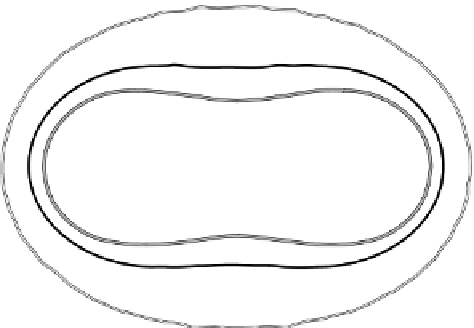Biomedical Engineering Reference
In-Depth Information
Number of molecules that enter the cell at
t
= 5 sec
10
8
6
4
2
5000
0
5000
-2
-4
1000
500
-6
-8
100
-10
-14
-12
-10
-8
-6
-4
-2
0
2
4
6
8
10
12
14
FIGURE 2.10
An example of the number of molecules that are expected to enter cells at
various parts of the tissue.
in concentration from the initial value. The drop in drug concentration in the
cube with volume
V
0
around a cell is attributed to molecules flowing inside the
cell. Since the concentration is given in mol/mm
3
,
N
the number of molecules
per cell is
N
=
N
A
(
c
(
t
=0)
−
c
)
V
0
(2.12)
where
N
A
is Avogadro's number.
For the model and parameters in this example a simulation of 5 sec is
enough to illustrate the effects of reversible electroporation on the uptake of
bleomycin. Under different circumstances diffusion may be effective for longer
periods, depending on the resealing rate of the cells. Figure 2.10 shows the
average number of bleomycin molecules that are expected to enter cells at
different areas of the tissue 5 sec after electroporation. In the case of bleomycin,
no effect on the cell is expected when fewer than 100 molecules enter the
cytoplasm (Poddevin et al. 1991). For this reason the tissue outside of the
outer contour in Figure 2.10 will not be affected by the procedure. Roughly
70% of the cells that have been penetrated by 500 or more molecules per cell
were expected to die (Tounekti et al. 1993), and the probability of cell death
increases further with the increase in the amount of bleomycin absorbed by
the cell.






Search WWH ::

Custom Search